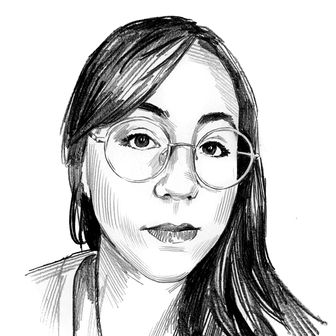
Adam Pearson doesn’t show up until maybe two thirds of the way through A Different Man, and while that’s by design, once he did, I really wished he’d been there from the start. Pearson, whose first acting role was as one of the men the Scarlett Johansson alien picks up in Under the Skin, has neurofibromatosis, the same genetic condition responsible for the facial deformity that the film’s protagonist, Edward (Sebastian Stan), has then is cured of. A Different Man, which was written and directed by Aaron Schimberg, is filled with internal rhymes, from the repeat appearance of the Toni Morrison novel The Bluest Eye to mentions of the dog Edward doesn’t actually own (though he does briefly acquire a cat). Pearson’s character, Oswald, is the most significant of these acts of thematic alliteration — an outgoing foil to the sullen Edward who looks a lot like Edward did before his treatment but who’s comfortable in his skin in a way that Edward has never been. But Pearson, as happy-go-lucky charmer, also brings a burst of much-needed vitality to this droll but overly thought-through film. He’s a living, breathing complication to the considerations of representation and authorship that Schimberg explores. But he’s also a full-fledged character shouldering his way into a work that can otherwise feel claustrophobic in its concerns, like listening to someone having an argument with themself.
It’s hard to find a criticism of A Different Man that the film doesn’t articulate itself. In particular, there’s the matter of Edward’s passivity, which Edward complains about when he ends up starring in an Off Broadway play that no one else knows was actually inspired by his life (it’s a long story). Edward is awkward, jumpy, prone to going through life as though anticipating a blow that’s yet to come. He looks like Woody Allen, someone says in passing, an observation that may not be visually true — Stan is at that point wearing prosthetics that create the look of someone with facial tumors — but that’s spiritually dead-on. With his high-waisted pants and rounded shoulders, Edward is impossible to pin down in terms of age or relative hipness, as though he grew up untethered to the normal markers of time. Or to other people — Stan plays the character with a tenderness that doesn’t dilute his prickly desperation, which comes out when an attractive aspiring playwright named Ingrid (The Worst Person in the World’s Renate Reinsve) moves into the apartment next door. He yearns with his whole body to be seen as a romantic possibility — but also is so unused to physical contact and so prepared for rejection that he flinches away from her.
It’s hard to imagine how someone who tries so hard to make himself invisible ended up wanting to be an actor, but when Edward auditions for roles he inevitably doesn’t get, we see that he’s good. The one part he does get is in a corporate anti-discrimination video that serenely assures its viewers that strong reactions to atypical faces is natural, just a fight-or-flight reaction from their reptile brains. A Different Man, which was shot in 16-mm film that gives an extra lived-in texture to its world of beat-up New York apartments and cramped Off Broadway venues, has a keen sense of the absurd that leads to scenes in which Edward watches from his apartment as a jingle-blasting ice-cream truck tries to navigate around the ambulance taking away a neighbor’s body. Schimberg, whose last feature was a riff on the 1952 exploitation film Chained for Life that also starred Pearson, has a keen interest in what goes unsaid when it comes to someone who’s going through life with an appearance that sets them apart, and how that desire to be careful and correct can create its own sense of isolation. Edward may not face grade-school cruelty anymore, but being treated with kid gloves by people who won’t actually be upfront about what’s on their mind is its own kind of torment.
It’s torment that leads Edward to undergo an experimental procedure with miraculous results that leave him looking, well, like a movie star. Stan’s gotten a lot of praise for this role, though what makes his work so compelling is his willingness to do very little in his scenes, both in and out of the prosthetics — to withdraw into Edward’s own paralyzed self-consciousness. For someone who frets about connecting with others, Edward isn’t always present himself, prone to retreating into his own head as the sound fades around him, and struggling to connect with the version of himself Ingrid writes for the stage when she believes Edward died, not realizing that the handsome actor she’s chosen for the role is actually her former neighbor. That’s one of the reasons Pearson, when he bursts onscreen as a charismatic Englishman who’d been told about the play by a casting agent, feels like such a relief. Oswald provides an easy solution to the ironic issues about authenticity that Edward finds himself facing when he starts wearing a mask to re-create his past appearance.
But, chatty and confident and funny, Oswald is also a much-needed counterpoint to Edward, who, even when given the opportunity to start over with a new face and name, can’t escape his own insecurities, a character constantly and exasperatingly stuck in one place. The slipperiness and span of time that A Different Man covers make it feel like a junior version of Synecdoche, New York, Charlie Kaufman’s drama about a theater director making his inward-burrowing dream project. But Schimberg’s film is more distant and less personal, and it’s only really when Pearson shows up that it’s clear how much we needed the fresh air he brings with him.
More Movie Reviews
- Fernanda Torres Is a Subtle Marvel in I’m Still Here
- Grand Theft Hamlet Is a Delightful Putting-on-a-Show Documentary
- Presence Is the Best Thing Steven Soderbergh’s Done in Ages


